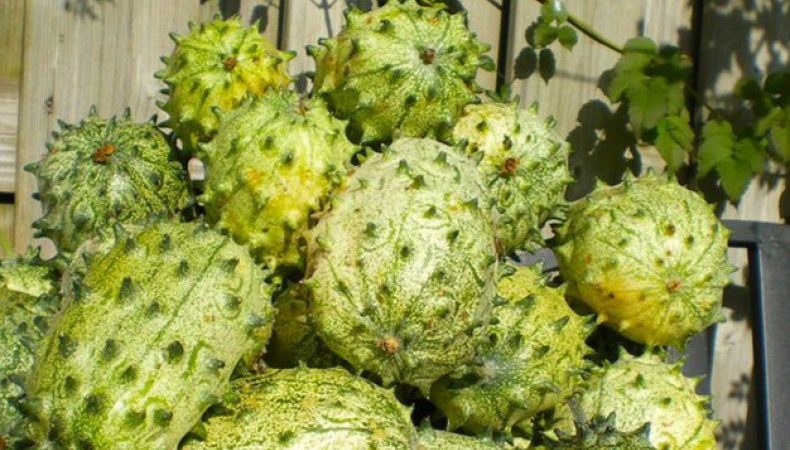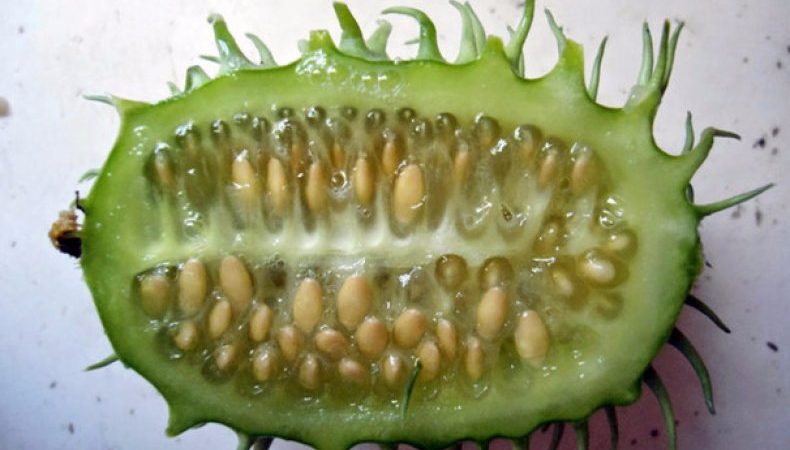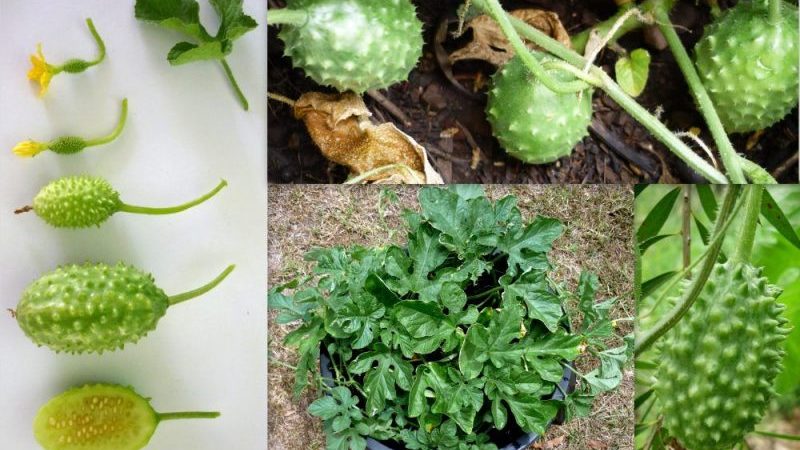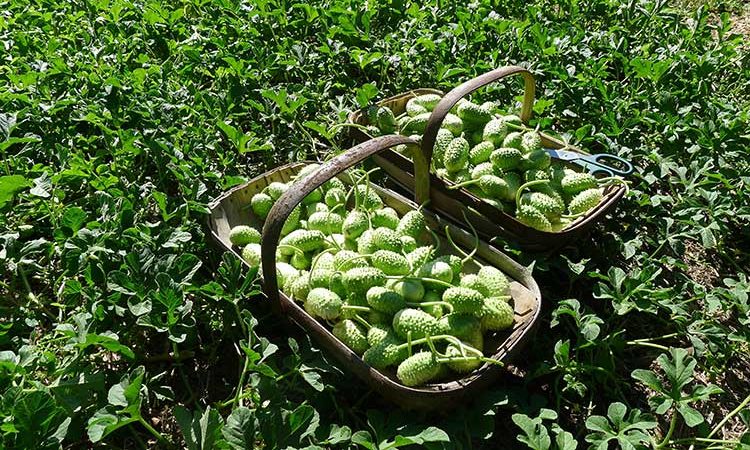What is anguria and how to grow it
Traditionally, products that are familiar and familiar to everyone are used in cooking. However, there are also exotic lovers who prefer to grow and consume unusual, rare crops. One such fruit is anguria, which is popular in European cuisine and is increasingly appearing in Russian dishes.
The content of the article
What is Anguria
Anguria's natural habitat is tropical and subtropical climatic zones. Its second name is Antilles cucumber, it belongs to the genus of the same name Cucumis (Cucumber) and the Pumpkin family.
In the wild, the plant with a bitter taste was first discovered in South Africa and Madagascar, and over time the seeds were brought to America. In Australia, the vegetable is considered a weed and regular work is carried out to eradicate it from the sites.
On the territory of Russia, many gardeners are already trying to grow anguria as a fruit and ornamental crop.
Description and its varieties

Antillean cucumber belongs to annual liana-like plants, its fruits are outwardly similar to the well-known cucumbers, but plump and covered with small thorns-horns... Anguria grows in shrubs reaching 5-6 meters in height. She forms original leaves - carved, curly shapes, reminiscent of the foliage of melons, but covered with small thorns.
During the flowering period, many fragrant yellow flowers, similar to cucumber ones, are formed on the plant. Due to its active flowering and lush green mass, it is used as a hedge in summer cottages, for decorating fences and even building facades. Anguria blooms and forms fruits from early July until the first frost and gives a rich harvest with proper care.
reference... The ripe fruit has a bright green color with light stripes, is covered with small, soft spine-like processes and resembles a thick cucumber in shape - about 8 cm in length and up to 4 cm in diameter. Average weight is about 45 g.
Only young fruits are used for eating. They have medium density pulp, juicy, saturated with sugars and vitamins. A fully ripe seed fruit is yellowish-orange in color, but color may vary depending on the region of cultivation.
The interval from the moment the first shoots appear to harvest is about 65-70 days, after which the Antillean cucumber is considered inedible.
Varieties

The only officially registered variety in the state register of the Russian Federation is Diet Anguria. It is recommended to grow in greenhouse conditions, and it takes about 50 days to mature.
Gardeners prefer to use other varieties that are cultivated in foreign countries:
- "Gourmet" - lianas, reaching 3 m in height, produce oval fruits of light green color, covered with large soft spines. Young vegetables are eaten, and overripe dried specimens are used as elements of decorative and floral compositions.
- "Anguria Syrian" - large liana-like plants up to 4 m with numerous shoots and large fruits (up to 55 g) covered with small thorns. Sweet on the palate, used as decorative elements for various dishes.
Important! Often inexperienced gardeners confuse Anguria with Kiwano - African cucumber or horned melon.These are relatives, have some external similarity, but differ in taste, resemble banana pulp and grow up to 350 g.
Its benefits and harms
Anguria is considered a valuable and healthy fruit. Its pulp contains 88% water, as well as fiber, ash, organic acids and saccharides. The product also contains magnesium and calcium, sodium and zinc, potassium and iodine, phosphorus and iron, selenium and copper. In addition, there are B vitamins: B1, B2, B3, B6 and folic acid (B9). The Antilles cucumber is saturated with vitamins K, E, C, PP, D, contains choline and other valuable minerals.
Antillean cucumber is suitable for a dietary diet, since with a low calorie content (44 kcal) it is able to satisfy the body's needs for all the necessary macro- and microelements.
Reference. A unique property of anguria is its inability to accumulate dangerous nitrates.
The Antillean cucumber is recommended to be included in the diet due to its versatile positive effects on the body:
- it normalizes metabolic processes;
- stimulates the immune system, helping the body to resist viruses and infections, is useful for both the prevention and treatment of ARVI;
- activates the digestive system, stimulates the intestines due to its high fiber content;
- gently removes toxins and toxins, does not overload the intestines;
- helps to lose weight with regular use, removes excess water;
- strengthens blood vessels, makes them elastic and prevents the risk of thrombosis and varicose veins.
Anguria is useful in case of disorders of the cardiovascular system and to stabilize blood pressure. In addition, it fights inflammation from the inside, which affects the external condition of the skin.
Antillean cucumber can be consumed by everyone, without exception - there are no specific contraindications, except for individual intolerance... It is advised with caution to use anguria for urolithiasis and during pregnancy.
Features of the use of Antillean cucumber

Anguria is most commonly used in cooking. Fresh salads and snacks are prepared from it, and the beneficial properties are preserved even after freezing the fruits.
Pickled and canned Antillean cucumbers are a real delicacy with a pleasant sour-sweet aftertaste that real gourmets will love.
It is possible to use the fruits in the following ways:
- as an anthelmintic - dilute the dried and crushed seeds to a mushy state with water and use 1-2 tablespoons per day;
- ointment for bruises - mix fresh cucumber juice with a small amount of olive oil;
- with ringworm - pour the leaves with vinegar, insist and use to wipe the skin;
- fresh juice helps get rid of freckles;
- an effective diuretic composition is obtained from the decoction of the roots.
Another area of use of anguria is home cosmetology. Its juicy pulp is great for making face masks. The beneficial vitamin and mineral composition rejuvenates and nourishes the skin, makes it look healthy and removes wrinkles.
Aesthetic fruits are often used as interior decorations or Christmas trees.
It is interesting:
Overview of Chinese Bitter Melon (Momordiki).
What is momordica charantia: an overview of an exotic vegetable.
Secrets of growing anguria
Antillean cucumber is a thermophilic plant, because it is of tropical origin. But with proper care, the fruits can be grown in a temperate zone. The optimum temperature range is from + 20 ° C to + 29 ° C, a mark of + 32 ° C or a decrease to + 8 ° C are considered critical.
For planting Antilles cucumber, it is better to choose fertile black soil or neutral sandy loam soil. Lime can be added to the soil to reduce acidity. The plant is recommended to be planted in the beds where it previously grew: beets, cabbage, legumes, greens.
Important! You cannot choose soils for anguria with a close occurrence of groundwater - they will provoke rapid decay of the root system.
The growing area should be well-lit and sunny, an exotic cucumber does not tolerate shading and does not like drafts. Considering that the period from emergence to harvesting of fruits is about 55 days, it is better to plant a culture with seedlings.
Planting and leaving
In most regions, it is recommended to use greenhouses for growing, however, proper care and attention to the plant will allow you to get a rich harvest from an open area.

Soil preparation
The soil is prepared in the fall: the site is dug up, a nutrient composition is added for each square meter of the following components:
- 35 g superphosphate;
- 0.5 buckets of humus or compost;
- 20 g potassium sulfate;
- 0.5 cups of wood ash.
Immediately before planting, carbamide is introduced into the loosened soil - a small pinch per square meter.
Seed preparation
The planting material is sorted out, leaving only large seeds. They are soaked in a weak manganese solution for 3-4 hours, then placed in any growth stimulator, for example, "Epin", for a day.
The prepared seeds are spread on several layers of gauze, covered with it and left in a warm and bright place. It is important to ensure that the fabric always remains moist, then the seeds will hatch in a few days and can be transferred to peat cups (or tablets). For transplantation, the peat base is moistened with water, after its increase in size, a hole 1 cm deep is made, the seed is placed and carefully sealed.
Reference. You can make a homemade mini greenhouse by covering a peat tablet with a glass or plastic cup.
Landing schemes and technology
After the first shoots hatch after 7-8 days, you can wait for the active growth of seedlings... In order not to provoke the stretching of young stems, daytime lamps are installed above them. At least 3-4 young leaves should form on the stems, only after that the plant can be sent to the site.
According to the placement scheme, one anguria seedling will require a place of 50 * 40 cm.If the culture is planted as a decorative hedge, then up to 80 cm is left between young shoots.
There must be at least 50 cm between the Antillean cucumber and other plants, otherwise an unwanted shadow will be created. If from any side the area is blown by the wind, it is recommended to plant corn. Dill, coriander, or parsley should be grown nearby to encourage cross-pollination.
The landing procedure is as follows:
- dig deep holes so that the seedling fits completely;
- cultivate the soil by spraying it with a weak manganese solution;
- in each hole - 2 liters of humus and a pinch of ash;
- the plant is placed and buried to the level of the cotyledon.
Important! The Antilles cucumber needs to be tied up, so trellises are installed along the planted rows. As soon as the "antennae" are formed at the seedlings, they are directed to the support.
Seedlings can be transferred to the soil only after it has warmed up to + 10 ° C.
Watering mode
Watered as the soil dries up, although the culture is moisture-loving, it does not tolerate moisture stagnation at the roots. It is advisable to use only warm and settled water. Do not allow waterlogging of the land near the stem, watering - strictly under the trunk at the rate of 12-14 liters per square meter.
If the summer is hot and dry, the crop is watered daily after sunset. During the rainy period, it is better to suspend the moisture completely. The plant especially needs moisture during fruiting.
Top dressing
It is recommended to fertilize anguria once every 15 days. She requires both mineral and organic compounds, which are suitable for:
- Mullein - mix a quarter of a bucket with 10 liters of water, insist until the end of fermentation, dilute the finished composition with 4 buckets of water and water at the rate of 10 liters per square meter. m.
- Chicken droppings pour water in a ratio of 1: 2, leave for several days in a warm place. Dilute a liter of the finished composition in 10 liters of water and water two hours after watering in dry weather.
The optimal complex mineral fertilizer is nitrophoska. Three tablespoons of the drug are diluted in 10 liters of water and 0.5 liters are poured under each bush.
Topping
As soon as the first ovaries appear on the bush, they pinch it. This stimulates the growth of the second row of shoots, which provide the bulk of the crop.
Pinching will exclude active growth of culture on the site, which leads to a lack of sunlight.
Protection against diseases and pests
The Antilles cucumber is affected by powdery mildew, anthracnose, root or white rot. These fungal diseases develop due to violations of the rules of care or excessive watering of the soil. The damaged parts of the vines are removed, after which the plants are treated with "Fundazol", "Maxim".
Of the pests, the most dangerous are melon aphids or spider mites. The compositions "Aktellik", "Aktara", "Fitover", "Agravertin" are effective against them.
Do not harvest the fruit after processing. For the prevention of diseases and pest attacks, it is recommended:
- periodically treat garden tools with disinfectants;
- remove weeds from the site;
- loosen the soil regularly;
- feed the culture in a timely manner;
- check bushes for signs of damage.
Harvesting
Young fruits are collected, not overripe specimens of a beautiful green color. Remove them from the bush in the morning, before the onset of the heat. Then they will be more juicy, richer, and better stored.
Harvested cucumbers are more comfortable in a cool place, and gardeners claim that they can survive this way even until mid-winter.
What do experienced gardeners say about Anguria

Anguria is not the most popular plant in Russia; it is not grown everywhere, and even more so on an industrial scale.... Summer residents plant an exotic cucumber only for personal consumption, use it for food or as a decorative decoration.
Some summer residents begin to grow Antillean cucumber for the sake of experiment, but having tasted it, they begin to add it to salads and even preserve it.
What is the yield
The yield from one bush is about 150-200 fruits with proper care, and the seeds remain viable for up to four years. From 10 sq. m it is possible to get about 22 kg of cucumbers.
Read also:
How to cure white rot in a greenhouse.
The use of superphosphate for fertilizing cucumbers.
What are the diseases of cucumber seedlings: photo and description.
Conclusion
Growing an exotic Antillean cucumber on your own plot is no more troublesome than caring for regular cucumbers or potatoes. It is enough to follow the rules of agricultural technology, to provide comfortable conditions for the culture in order to collect a rich harvest of useful and tasty fruits in the form of unusual green hedgehogs.